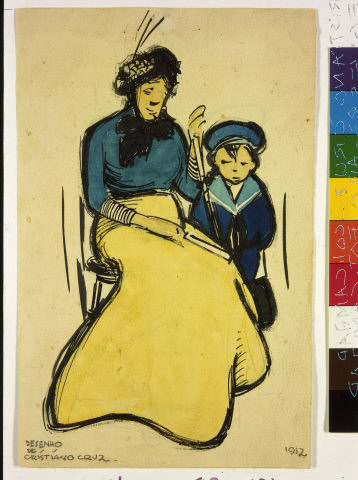
Cristiano Cruz
s/título
Leiria, Portugal, 1892 – Cuito, Angola, 1951
Cristiano, or Christiano, completed secondary school in Coimbra, which was where he began his artistic work, and went to Lisbon to study Veterinary Medicine (1910-15), soon after the foundation of the Republic. While still a student, he gained instant recognition for his comic work, with cartoons published regularly in the newspapers (O Gorro, Novidades, A Farsa, A Luta, A Capital, Centauro, Águia, Rajada) and his pioneering work was praised by Jorge Barradas, Stuart Carvalhais, José Pacheko and Almada. Together with these artists, he founded the Sociedade de Humoristas Portugueses [the Portuguese Society of Humourists], of which he was the third member, and he showed his work at the 1st and 2nd Humourists’ Show (1912-3) at the Grémio Literário, Lisbon. Cristiano made his name in the history of modernism through his rejection of the 19th century political cartoon; instead he offered up his original and stylised form of successful ’impersonal caricatures’ where he introduced the graphic artist as a ’visual novelist’ who illustrates ideas critiquing society and its customs. Over the same period, he gained public notoriety for his incendiary statements to the press, which ended up making him the spokesman of a generation. He propounded avant-garde ideals of non-submission that countered public expectations and academic demands, and that generated his saying “War on Fuddy-Duddies!” to repudiate the traditionalist and conservative inheritance of the Grupo do Leão, and of “art that delights only to be seen,” thereby stirring up artistic circles through new creative approaches.
In 1913, in the midst of the controversy around Portuguese modern art, Cristiano stepped away from the comic drawing that had established him as an artist, and began his ’stylised period’. This led to a more rigid drawing style with an expressionist violence reminiscent of Egon Schiele, and which was no longer aimed at the newspapers he had published in before, but was for his own artistic expression. After 1915, the year in which he completed his degree in Veterinary Medicine, painting took on a more central role in his life, and was more openly expressionist and always in small formats. Despite declaring that “the environment stimulates no-one”, he then began a productive phase that represented his final creative years (1916-19), from which around twenty paintings survive. These introduced a new and consistent language to his artistic trajectory, with self-portraits and symbolist and mundane iconography, in which his painting surpassed his drawing (being directly applied on the canvas) and his earlier humorous intentions, and which had an unrestrained artistic radicalism only comparable to that of Amadeo de Souza-Cardoso. These works, however, were not well-received when he showed nine of the paintings at the 1st Humourist and Modernists’ show (1916), and this limited the acceptance of his work for entry the following year.
In January 1917, he set off for France, where he fought on the western front of the Great War as a second lieutenant with the 1st Portuguese Expeditionary Corps. He was the only Portuguese artist of significance to be involved in the tragedy, and it led to his creation of an album of pencil and India ink drawings, Cenas de Guerra [War Scenes], and to a collaborative illustration, with Diogo de Macedo, of Augusto Casimiro’s book, Nas Trincheiras da Flandres [In The Trenches of Flanders] (1918). While still in France, – with a short trip to Lisbon for his doctoral viva in Veterinary Medicine – he continued to paint small gouaches and oils on card, and explored the textures of the support, with fierce colour contrasts and themes of extreme psychological states, from the anguish of war to the melancholy of daily city life – like that shown in S/Título (Senhoras à mesa) [Untitled (Ladies at a table)] – which he continued to produce on his return to Portugal at the end of 1918. The indecision of the following period, which saw bitter and wounding episodes in his artistic life, led Cristiano to abruptly put an end to one of the most promising artistic careers of his generation at only 28 years old. In October 1919, he left for Mozambique in self-imposed exile, something that took on mythical proportions among other artists from the metropolis. He left only a few self-portraits, sketches of objects, and some lesser works, and Dr Sheppard Cruz lived in Mozambique until 1950, where he practised veterinary medicine at posts in Lourenço Marques, Quelimane, Magude, Bilene and Chobela. He regularly visited South Africa but only visited Lisbon twice (in 1923 and 1930). In 1951, political conflicts led him to be transferred to Angola as head veterinarian for the Bié province, based in Silva Porto (now Cuito), where he passed away soon after. Despite his early and definitive departure from artistic circles, the 50th anniversary of his death and the centenary of his birth have made it possible to reinstate his influential and innovative role in Portuguese art. He was an exponent of a never entirely fulfilled modernist and avant-garde potential, and has had retrospectives at CAM and the Museu Bordalo Pinheiro (1991), and the Museu da Cidade de Lisboa (1993), in addition to other exhibitions and modernist stories that pay him tribute.
Afonso Ramos
March 2013